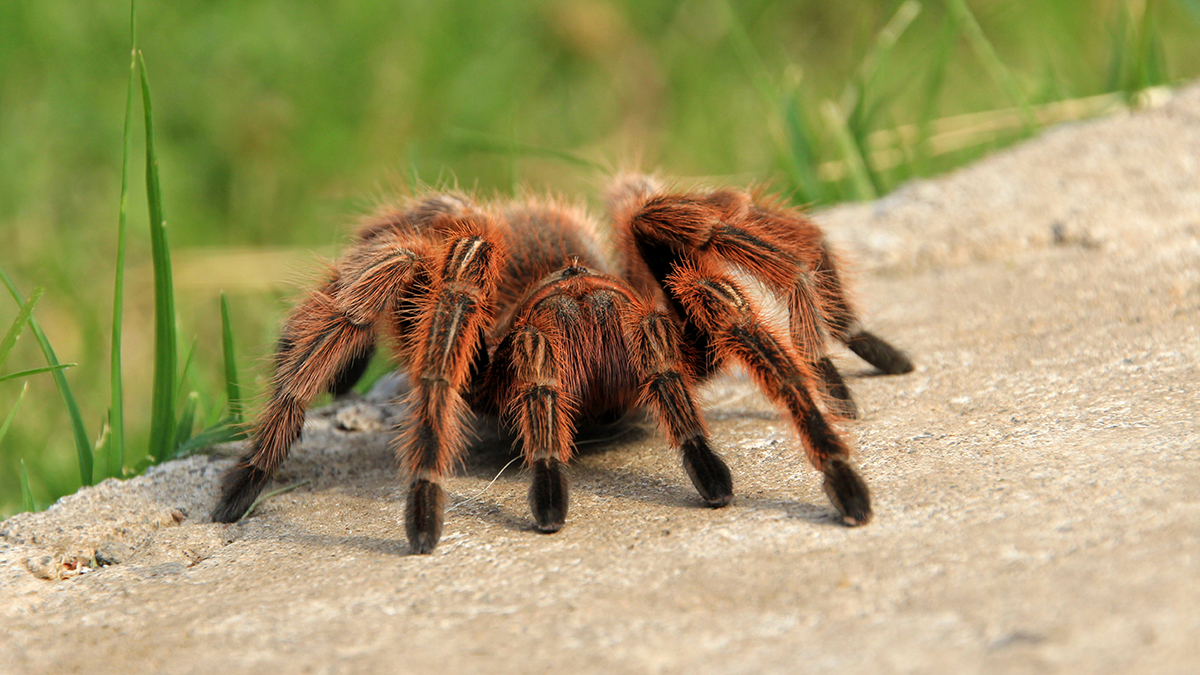
Species Overview
- Common Names: Chilean rose tarantula
- Scientific Name: Grammostola rosea
- Distribution: Found in deserts and scrublands of Bolivia, Argentina, and Chile
- Adult Size: Leg span of 4 1/2 to 5 1/2 inches
- Life Expectancy: Females live up to 20 years, and males live up to 5 years
The Rose-hair Tarantula is an exquisite pet. They range in color from light grey to a subtle pink to a vibrant rose. The tarantula has a docile demeanor and is low maintenance. These creatures are the perfect pets for spider lovers.
About the Rose-hair Tarantula
Rose-hair Tarantula Pet Care: Habitat Set-Up
Habitat
- A small 5-gallon to 10-gallon tank or terrarium is usually suitable. When choosing your tank size, remember that the Tarantula’s habitat should be two to three times wider than its leg span, and the height should be as tall as the spider’s width. Be sure to allow room for a thick substrate for burrowing.
- The Tarantula needs a hiding space. The hiding space can be a hollowed-out log, branches, or cork bark.
- Artificial or live plants provide good additional coverage, making your pet Tarantula feel calm and safe.
Heating
- Terrarium Temperature 70-85 F. An under-tank heating pad is recommended when the temperature in your home falls below this range.
- The Chilean Rose Tarantula dislikes humidity and becomes agitated when damp spots appear in its cage. Maintaining a dry environment (not parched) is critical for a happy habitat.
Lighting
- Keep the Rose-hair Tarantula in a darker part of the room, away from sunlight. Avoid incandescent lights that can dry out a tarantula, instead use a nocturnal or infrared light to watch your Tarantula after dark.
Substrates
- Tarantula needs two to three inches of dampened sphagnum moss, soil, vermiculite, coconut fiber bedding, or reptile bark for an excellent substrate. Do not use gravel and artificial turf because they’re too harsh for their skin.
- The bedding that lines the floor of your spider’s tank allows the Tarantula to burrow.
Maintenance
- Thoroughly clean and disinfect the habitat at least once a week.
- When cleaning your habitat, place your Rose-hair Tarantula in a separate secure space.
- The tank and furnishings need scrubbing with a 3% bleach solution.
- When finished, rinse thoroughly with water and remove all traces of the bleach smell.
- Dry the tank and furnishings before adding a clean substrate.
Rose-hair Tarantula Pet Care: Temperament
- The Rose-hair Tarantula is a nocturnal spider and is usually calm and submissive. However, when handled often, the Rose-hair Tarantula can become aggressive or fussy and will usually raise its front legs to alert you of a potential bite.
- They have spine-like hairs on their abdomen that contain a mild venom. These spines release (or shoot out from their body) when threatened and can cause an irritating rash on human skin.
- Chilean rose tarantulas are known for their peculiar behavior. This behavior includes burrowing, filling their water bowl with dirt, and “redecorating” their habitat.
Diet and Nutrition
- The Rose-hair Tarantula’s digestive tract, designed for digesting liquid food, happens by the spider vomiting digestive enzymes onto its food to break it down into a liquid before slurping it up.
- Chilean Rose Tarantulas enjoy live crickets and other giant insects as their prime food source. Be sure that food is smaller than the tarantula, and remove any uneaten live feed as it may cause injury to a resting tarantula.
- Adult tarantulas usually eat once or twice a week, whereas immature spiders feed more often. Since they are nocturnal, feeding should occur at night.
Water
- A small water bowl placed inside the Rose-hair Tarantula’s enclosure should keep it well hydrated. Keep the clean, chlorine-free water fresh and change it daily. Be careful when refreshing the water. Do not spill. The Rose-hair Tarantula will become stressed if their substrate is soaked.
Pet Safety
- Use caution when handling pets, and remember they may bite or scratch (especially when stressed).
- Supervise children around pets.
- ALL ANIMALS can potentially carry viral, bacterial, fungal, and parasitic diseases contagious to humans.
- Thoroughly wash your hands with warm, soapy water before and after contact with any pet or its habitat.
- Adults should assist children with handwashing after contact with a pet, its habitat, or aquarium water.
Related Searches
Creature Care